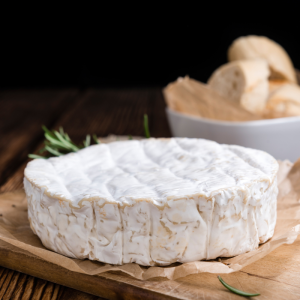How does a white mould cheese mature?
 The cheeses that have a white mould covering mould on the outside are classed as bloomy rind cheeses. The white mould that grows on the outside of the cheese is known as Penicillium Candidum or white mould spores or PC or PCA. Camembert and Brie are the two most well known white mould kinds of cheese, but there are also several others such as Chaource, Neufchatel, Coulommiers, Brillat Savarin, Cremeux d’Argental and Mont dÒr. Bloomy rind cheeses are ripened from the outside in, courtesy of these yeasts and moulds on the surface of the cheese. The ripening commences on the surface of the cheese (the rind) and then proceeds to the inside of the cheese (the paste).
The cheeses that have a white mould covering mould on the outside are classed as bloomy rind cheeses. The white mould that grows on the outside of the cheese is known as Penicillium Candidum or white mould spores or PC or PCA. Camembert and Brie are the two most well known white mould kinds of cheese, but there are also several others such as Chaource, Neufchatel, Coulommiers, Brillat Savarin, Cremeux d’Argental and Mont dÒr. Bloomy rind cheeses are ripened from the outside in, courtesy of these yeasts and moulds on the surface of the cheese. The ripening commences on the surface of the cheese (the rind) and then proceeds to the inside of the cheese (the paste).
When you make a white mould cheese, you are looking to get that lovely white covering about 7 to 10 days after you have made the cheese. Then you wrap the cheese and wait for it to mature. After wrapping is where most of the ripening happens, under the cheese wrap, during that affinage. Ideally, you still have that white mould covering still nicely evident at several weeks after you made it. It gives you that good first impression of being a well made cheese. Then the smell and taste to come will hopefully confirm this. There are several things happening during the several weeks after you make the cheese but before you get to taste the cheese.
The ripening of Camembert cheese occurs in two steps: the initial white mould growth that is happening in the container that has the appropriate humidity and temperature. The second stage of ripening occurs when the cheese is wrapped and stored at 4–6 °C. This is where the paste changes from firm and chalky to one that is soft and viscous.
White mould cheeses undergo various biochemical changes during ripening during these two stages. This will lead to its unique aroma and typical flavour characteristics. The ideal pH range of Camembert at salting is usually between 4.7 and 4.9.0, however, the white mould spores will not grow well at this level of acidity. The ripening commences almost immediately the cheese is hooped. The consumption of the residual lactose is soon followed by the consumption of the calcium lactate on the cheese surface by the yeasts such as Debaryomyces hansenii, Candida utilis and Kluyveromyces lactis. The Geotrichum candidum also does the same but it starts this process later than these other yeasts. All of these yeasts tolerate the cheese acidity well, but not so the hite mould spores. As the acidity of the cheese decreases after several days, the white moulds can start to grow. The rate of deacidification then decreases at a much faster rate due to the white mould activity. While this is happening on the surface of the cheese, the calcium lactate from the inside of the cheese diffuses to the outside of the cheese and ammonia and flavour compounds migrate the inner paste. As time progresses over the following weeks, the outer parts of the cheese turn to a soft paste while the inside still remains chalky. As time progresses, that soft paste progresses to the centre of the cheese.
There are several things that you can do to help get better white mould growth.
 Adding yeasts and white moulds to the milk and to the brining solution
Adding yeasts and white moulds to the milk and to the brining solution
Adding one or more yeasts including Geo, DH, KL, CU help deacidify the acidity on the surface of the cheese so that the white mould can get established faster. Two things that come from adding yeasts. Each yeast contributes its own flavour to the cheese. And secondly, the faster that you can get the white mould established, the lesser chance of getting leathery rinds. You only need to add these yeasts to the milk but by also adding them to the brine there is a little bit of extra surety that they will be on the surface of the cheese. Geo is the most salt sensitive of these but it will still survive the brining process.
White mould will not grow with wet feet
The cheese shape at demolding should have a flat surface. If you have cheese with a curved surface, as in a saucer shape, moisture will build up on the surface of the cheese. It is too late to rectify this condition, but you can turn the cheese more regularly and place the cheese on an angle/tilt to that moisture runs off the cheese.
Also, flip the cheese in their forms straight after hooping, several times to make sure the moisture draining is even.
White mould will not grow well over 95%. Keep the humidity level to just under 95%.
After demolding, turn the cheese regularly while the yeasts and the white moulds are growing. If you don’t turn the cheese often enough in the first few days after demolding, you will see a build up of moisture on the underside of the cheese. Turning also assists in moisture removal and also allows fresh oxygen to the surface of the cheese which the white mould requires.
Cheese is too fatty and has a high pH
Many people have been accustomed to making the fattier Bries and Triple cream cheeses. These cheeses with higher fat content restrict or slow down the growth of the culture in the curd. For example, if the type and volume of starter culture were added to milk at the same temperature but if one of those milk had a higher fat content, the milk with the higher fat content would produce less acid and would also have higher moisture. This lower acid level would cause less migration of the minerals out of the cheese curd at hooping. This will cause a slowing of the consumption of the residual lactose and the calcium lactate on the cheese surface. Resulting in slower white mould growth.
Cheese is too wet or too dry
You should see no free moisture on the surface of the cheese 48 hours after demoulding. If you still have free moisture on the surface at 48 hours there is a cheese production issue, probably insufficient acid production or not leaving the cheese at > 27°C for 18 hours after it is hooped.
If the cheese is too dry, then the consumption of the residual lactose on the cheese surface followed by the slowing of the consumption of the calcium lactate cannot occur.
Dry Rind
The cheeses at no time should be allowed to dry off or harden on the surface; white mould will not grow well on a harder or drier surface.
Keep the cheese at 16°C for 24 hours after demolding for 24 hours
It is helpful to hold the cheese at 14c to 16c for 24 hours which favours the growth of the yeasts. After 24 hours of drying, the cheese needs to be held at 10°C -14c and at 90% – 95% relative humidity and turned every 24 hours. Regular turning is important for fresh oxygen and mould growth.
Keep the cheese at 10°C to 13°C for 24 hours after demolding for 24 hours
If the temperature in your cheese cave drops lower than 10°C, the white mould will grow at a slower rate.
 Using professional cheese wraps
Using professional cheese wraps
When the white mould is fully developed, it is ready for wrapping. Do not keep the white mould growing after the cheese is fully covered. Excessive white mould growth at this stage will cause a thick rind to develop. For best results, wrap the cheese in professional cheese wrap. Baking paper and foil etc. are more economical options, but professional cheesemakers do not use them for a reason. These wraps help regulated moisture and gases between the surface of the cheese and the wrap and help keep the white moulds healthy and white.
Wrapping the cheese cold
As mentioned earlier, white mould does not like wet feet. The cheese must be completely dry to wrap it, so avoid condensation or drips from the container walls and lid. Remove the cheese from the container, rinse the container well with boiling water, and dry the container with a piece of paper towel. Place the cheese on to rack in the container but with the lid off, at 4°C for > 4 hours. This will dry the cheese’s surface and cool the cheese. When the cheese is cold, remove it from the fridge and very quickly wrap the cheese in professional cheese wrap. Place the cheese back in a completely dry RC, including zero condensation or moisture, and replace the lid. Place the dry RC in the 4°C – 6°C fridge. The container will stop the domestic fridge’s evaporative air from drying the cheese while it ripens. Occasionally check the RC to make sure there is no moisture build up in the container.



